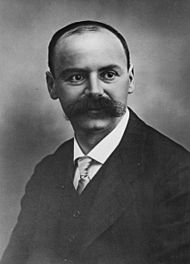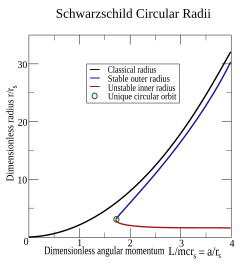Karl Schwarzschild facts for kids
Quick facts for kids
Karl Schwarzschild
|
|
|---|---|
 |
|
| Born | 9 October 1873 |
| Died | 11 May 1916 (aged 42) Potsdam, German Empire
|
| Alma mater | Ludwig Maximilian University of Munich University of Strasbourg |
| Scientific career | |
| Fields | Physics Astronomy |
| Doctoral advisor | Hugo von Seeliger |
| Influenced | Martin Schwarzschild |
| Military career | |
| Allegiance | |
| Service/ |
Imperial German Army |
| Years of service | 1914–1916 |
| Rank | Lieutenant |
| Battles/wars | World War I |
| Signature | |
Karl Schwarzschild (German: [kaːl ˈʃvaːtsʃɪlt]; 9 October 1873 – 11 May 1916) was a brilliant German physicist and astronomer. He is famous for being the first person to find an exact solution to Albert Einstein's field equations of general relativity. He did this for a simple case: a single, round, non-spinning mass.
Schwarzschild found this solution in 1915, the same year Einstein first shared his theory of general relativity. His work led to the idea of the Schwarzschild radius. This is the size of the event horizon for a non-spinning black hole. An event horizon is like a point of no return around a black hole.
What's amazing is that Schwarzschild did this while serving in the German army during World War I. He sadly passed away the next year from a rare skin disease called pemphigus. He developed this illness while fighting on the Russian front.
To honor his contributions, an asteroid, 837 Schwarzschilda, and a large crater on the far side of the Moon, Schwarzschild, are named after him.
Contents
Life and Early Discoveries
Karl Schwarzschild was born on October 9, 1873, in Frankfurt on Main, Germany. He was the oldest of six boys and one girl in a Jewish family. His father was a successful businessman in the city.
Karl went to a Jewish primary school until he was 11. Then he attended the Lessing-Gymnasium secondary school. He received a broad education, learning subjects like Latin, Ancient Greek, music, and art. However, he became especially interested in astronomy very early on.
He was a child genius! Before he turned 16, he had already published two scientific papers. These papers were about the orbits of binary stars, which are two stars that orbit each other.
After finishing school in 1890, he went to the University of Strasbourg to study astronomy. Two years later, he moved to the Ludwig Maximilian University of Munich. There, he earned his doctorate degree in 1896. His work was based on the theories of a famous mathematician named Henri Poincaré.
From 1897, Schwarzschild worked as an assistant at the Kuffner Observatory in Vienna. He focused on measuring the brightness of star clusters using photometry. His research helped create a formula that linked how bright starlight was, how long a photo was exposed, and the contrast on a photographic plate. This formula included something called the Schwarzschild exponent.
In 1899, he returned to Munich to complete his "Habilitation." This is an advanced degree needed to become a professor in Germany.
From 1901 to 1909, he was a professor and director at the important Göttingen Observatory at the University of Göttingen. There, he worked with other famous scientists like David Hilbert. In 1909, he married Else Rosenbach. Later that year, they moved to Potsdam, where he became the director of the Astrophysical Observatory. This was the top job for an astronomer in Germany at the time.
In 1912, Schwarzschild became a member of the Prussian Academy of Sciences.
Serving in World War I
When World War I started in 1914, Schwarzschild, who was over 40, volunteered to join the German army. He served on both the western and eastern battlefronts. He helped with ballistic calculations, which are important for figuring out how to aim artillery. He rose to the rank of second lieutenant.
While serving in Russia in 1915, he became very ill with pemphigus. This is a rare and painful skin disease that affects the immune system. Even though he was very sick, he managed to write three amazing scientific papers. Two of these were about the theory of relativity, and one was about quantum theory.
His papers on relativity were groundbreaking. They provided the first exact solutions to Einstein's field equations. A slightly changed version of these results is now known as the Schwarzschild metric.
In March 1916, Schwarzschild had to leave the army because of his illness. He returned to Göttingen. Sadly, two months later, on May 11, 1916, he passed away at the age of 42. His struggle with pemphigus likely led to his death.
He is buried in his family grave at the Stadtfriedhof Göttingen.
Karl and Else Schwarzschild had three children:
- Agathe Thornton (1910-2006) moved to New Zealand and became a classics professor.
- Martin Schwarzschild (1912-1997) became a well-known astronomy professor at Princeton University.
- Alfred Schwarzschild (1914-1944) stayed in Nazi Germany and was killed during the Holocaust.
Schwarzschild's Scientific Work
Karl Schwarzschild's most famous work is in the area of general relativity. Thousands of studies have been written about his solutions to Einstein's field equations. However, his scientific interests were very wide. He also worked on celestial mechanics (how objects move in space), measuring star brightness, quantum mechanics, and spectroscopy (studying light from stars).
Some of his other achievements include measuring variable stars using photography. He also improved optical systems, which are important for telescopes and cameras.
Physics of Photography
In 1897, while in Vienna, Schwarzschild created a formula known as the Schwarzschild law. This formula helped calculate how dark photographic material would become after being exposed to light. It included a special number called the Schwarzschild exponent.
The formula looks like this:  Here, i is how dark the photo looks. It depends on I, the brightness of the light source, and t, the time the photo was exposed. The letter p is the Schwarzschild exponent, a constant number. This formula was very important for taking more accurate photos of faint objects in space.
Here, i is how dark the photo looks. It depends on I, the brightness of the light source, and t, the time the photo was exposed. The letter p is the Schwarzschild exponent, a constant number. This formula was very important for taking more accurate photos of faint objects in space.
Relativity and Black Holes

Einstein himself was surprised that his complex field equations had exact solutions. He had only found an approximate solution. Schwarzschild, however, chose a clever way to set up his calculations. He found an exact solution, which he shared in a letter to Einstein on December 22, 1915. He wrote this letter while serving on the Russian front during the war. He famously ended the letter by saying, "As you see, the war treated me kindly enough, in spite of the heavy gunfire, to allow me to get away from it all and take this walk in the land of your ideas."
Schwarzschild's first solution describes the gravitational field around a perfectly round, non-spinning, and uncharged mass. This solution led to the concept of the Schwarzschild radius.
The Schwarzschild radius is calculated using this formula:
In this formula, G is the gravitational constant, M is the mass of the central object, and c is the speed of light in empty space.
If a very massive object shrinks to a size smaller than its Schwarzschild radius, it will collapse under its own gravity. This creates what is known as a Schwarzschild black hole. Inside this radius, nothing, not even light, can escape the black hole's pull. This happens, for example, when a neutron star becomes too heavy and collapses.
Works
The scientific papers and notes of Karl Schwarzschild are kept in a special collection at the Lower Saxony National- and University Library of Göttingen.
- Relativity
- Über das Gravitationsfeld eines Massenpunktes nach der Einstein’schen Theorie. Reimer, Berlin 1916, S. 189 ff. (Sitzungsberichte der Königlich-Preussischen Akademie der Wissenschaften; 1916)
- Über das Gravitationsfeld einer Kugel aus inkompressibler Flüssigkeit. Reimer, Berlin 1916, S. 424-434 (Sitzungsberichte der Königlich-Preussischen Akademie der Wissenschaften; 1916)
- Other papers
- Untersuchungen zur geometrischen Optik I. Einleitung in die Fehlertheorie optischer Instrumente auf Grund des Eikonalbegriffs, 1906, Abhandlungen der Gesellschaft der Wissenschaften in Göttingen, Band 4, Nummero 1, S. 1-31
- Untersuchungen zur geometrischen Optik II. Theorie der Spiegelteleskope, 1906, Abhandlungen der Gesellschaft der Wissenschaften in Göttingen, Band 4, Nummero 2, S. 1-28
- Untersuchungen zur geometrischen Optik III. Über die astrophotographischen Objektive, 1906, Abhandlungen der Gesellschaft der Wissenschaften in Göttingen, Band 4, Nummero 3, S. 1-54
- Über Differenzformeln zur Durchrechnung optischer Systeme, 1907, Nachrichten von der Gesellschaft der Wissenschaften zu Göttingen, S. 551-570
- Aktinometrie der Sterne der B. D. bis zur Größe 7.5 in der Zone 0° bis +20° Deklination. Teil A. Unter Mitwirkung von Br. Meyermann, A. Kohlschütter und O. Birck, 1910, Abhandlungen der Gesellschaft der Wissenschaften in Göttingen, Band 6, Numero 6, S. 1-117
- Über das Gleichgewicht der Sonnenatmosphäre, 1906, Nachrichten von der Gesellschaft der Wissenschaften zu Göttingen, S. 41-53
- Die Beugung und Polarisation des Lichts durch einen Spalt. I., 1902, Mathematische Annalen, Band 55, S. 177-247
- Zur Elektrodynamik. I. Zwei Formen des Princips der Action in der Elektronentheorie, 1903, Nachrichten von der Gesellschaft der Wissenschaften zu Göttingen, S. 126-131
- Zur Elektrodynamik. II. Die elementare elektrodynamische Kraft, 1903, Nachrichten von der Gesellschaft der Wissenschaften zu Göttingen, S. 132-141
- Zur Elektrodynamik. III. Ueber die Bewegung des Elektrons, 1903, Nachrichten von der Gesellschaft der Wissenschaften zu Göttingen, S. 245-278
- Ueber die Eigenbewegungen der Fixsterne, 1907, Nachrichten von der Gesellschaft der Wissenschaften zu Göttingen, S. 614-632
- Ueber die Bestimmung von Vertex und Apex nach der Ellipsoidhypothese aus einer geringeren Anzahl beobachteter Eigenbewegungen, 1908, Nachrichten von der Gesellschaft der Wissenschaften zu Göttingen, S. 191-200
- K. Schwarzschild, E. Kron: Ueber die Helligkeitsverteilung im Schweif des Halley´schen Kometen, 1911, Nachrichten von der Gesellschaft der Wissenschaften zu Göttingen, S. 197-208
- Die naturwissenschaftlichen Ergebnisse und Ziele der neueren Mechanik., 1904, Jahresbericht der Deutschen Mathematiker-Vereinigung, Band 13, S. 145-156
- Über die astronomische Ausbildung der Lehramtskandidaten., 1907, Jahresbericht der Deutschen Mathematiker-Vereinigung, Band 16, S. 519-522
- English translations
- On the Gravitational Field of a Point-Mass, According to Einstein's Theory, The Abraham Zelmanov Journal, 2008, Volume 1, P. 10-19
- On the Gravitational Field of a Sphere of Incompressible Liquid, According to Einstein's Theory, The Abraham Zelmanov Journal, 2008, Volume 1, P. 20-32
- On the Permissible Numerical Value of the Curvature of Space, The Abraham Zelmanov Journal, Volume 1, 2008, pp. 64-73
Images for kids
-
Schwarzschild, third from left in the automobile; possibly during the Fifth Conference of the International Union for Co-operation in Solar Research, held in Bonn, Germany
-
Schwarzschild at the Fourth Conference International Union for Cooperation in Solar Research at Mount Wilson Observatory, 1910
See also
 In Spanish: Karl Schwarzschild para niños
In Spanish: Karl Schwarzschild para niños
- List of things named after Karl Schwarzschild





